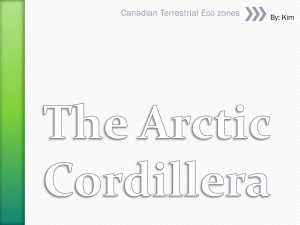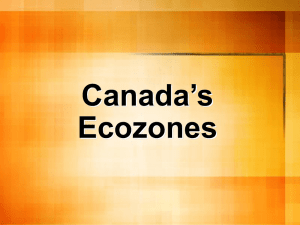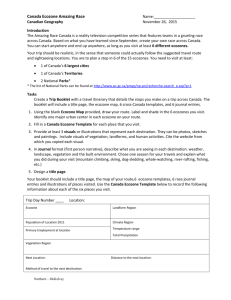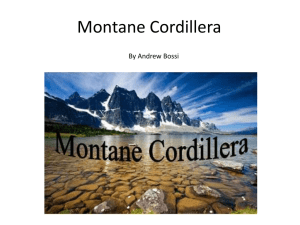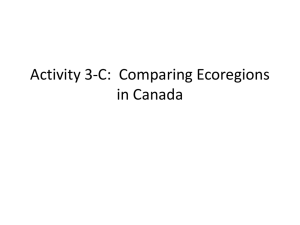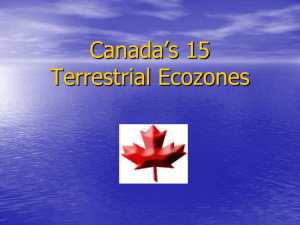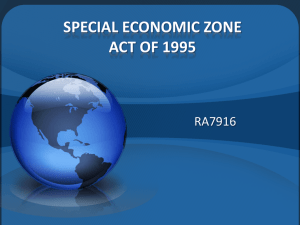Canada's Ecozones - Woodroffe High School
advertisement
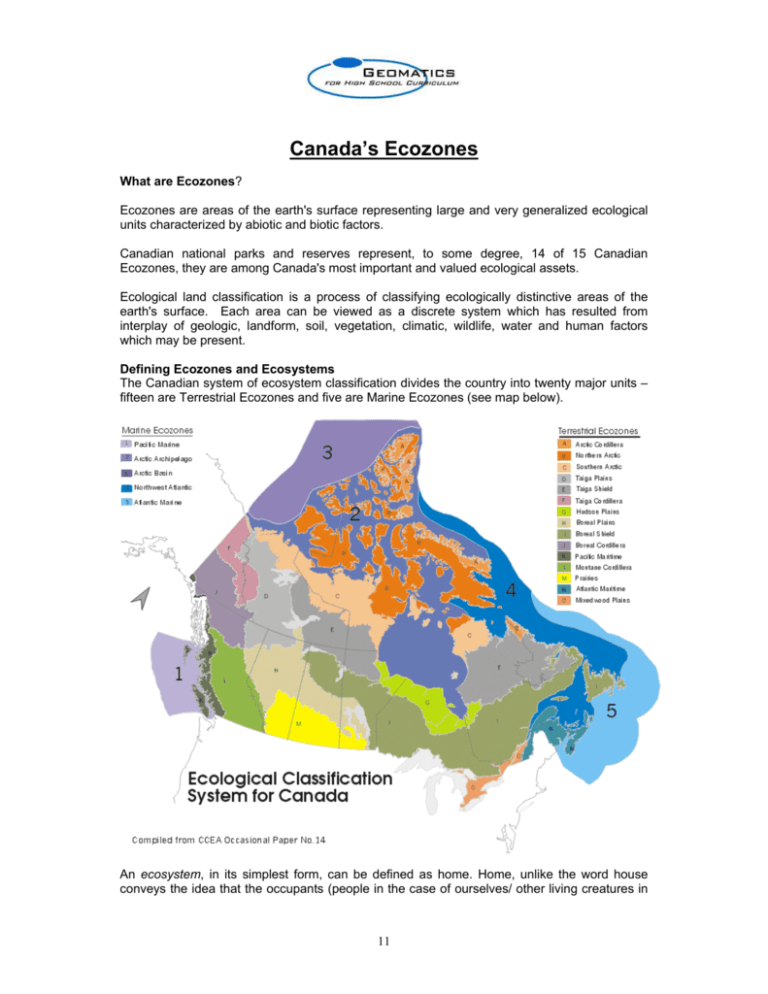
Canada’s Ecozones What are Ecozones? Ecozones are areas of the earth's surface representing large and very generalized ecological units characterized by abiotic and biotic factors. Canadian national parks and reserves represent, to some degree, 14 of 15 Canadian Ecozones, they are among Canada's most important and valued ecological assets. Ecological land classification is a process of classifying ecologically distinctive areas of the earth's surface. Each area can be viewed as a discrete system which has resulted from interplay of geologic, landform, soil, vegetation, climatic, wildlife, water and human factors which may be present. Defining Ecozones and Ecosystems The Canadian system of ecosystem classification divides the country into twenty major units – fifteen are Terrestrial Ecozones and five are Marine Ecozones (see map below). An ecosystem, in its simplest form, can be defined as home. Home, unlike the word house conveys the idea that the occupants (people in the case of ourselves/ other living creatures in 11 the case of the wilderness) are integral parts of the setting. As defined by Stan Rowe (1990) in his Home Place book, we and all other organisms are part of ecosystems and not apart from them. The concept of home therefore includes those who dwell there and everything that they may need or rely on to live. The State of the Environment Report (CCEA, Ed Wiken 1986) states in more scientific terms, that an ecosystem is defined as a unit of nature comprised of organisms (including people), the physical environment (land, water, climate) and the relationships that exist between them. Large order ecosystems in a landscape sense are called ecozones in the Canadian system of classification. These units depict areas of the earth’s surface where a fairly definitive and enduring mix of abiotic and biotic elements exist. They are all distinctive places with distinctive sets of characteristics. The structure, functions and processes associated with the biological and physical characteristics in each place is relatively unique and enduring. Each ecosystem/place is further characterized by relationships (dependencies, interactions, transactions, intra-actions) which exist between the inherent biological and physical parts or members --- these relationships are the cement which makes it possible for the system to hold together on a more or less permanent basis. The various order of ecosystems are related in a hierarchy in which a lower order ecosystem is nested within a higher order one. This hierarchy allows us to view Canada’s ecosystems from a broad perspective – the ecozones – or at a more detailed sub-unit level or at any level in between. The ecozones are sub-divided into ecoprovinces, which are further divided into ecoregions. These ecoregions, in turn, are sectioned into ecodistricts which are broken up into even smaller units of ecosections, ecosites and finally ecoelements. The fifteen (15) terrestrial ecozones of Canada are subdivided into 53 ecoprovinces, 217 ecoregions and 1021 ecodistricts. The Canadian marine ecosystem has not been completely defined at the lower order to date. There are 5 marine ecozones, some of which are subdivided into smaller sections while others are still only considered as a whole ecozone or ecoprovince. Ecozones Ecozones are areas of the earth's surface representative of large and very generalized units characterized by interactive and adjusting abiotic and biotic factors. Canada was first subdivided into 15 ecozones to meet reporting requirements of the first State of the Environment Report for Canada published in 1986 (Wiken 1986 ). The ecozone lies at the top of the ecological hierarchy as defined by the CCELC (Wiken 1979 ). In this context, the ecozone defines on a subcontinental scale, the broad mosaics formed by the interaction of macroscale climate, human activity, vegetation, soils, geological, and physiographic features of the country. The former Terrestrial Ecozones of Canada report is being updated and will also include descriptions for the recently developed marine ecozones Ecoregions Ecoregions are subdivisions of the ecozone characterized by distinctive large order landforms or assemblages of regional landforms, small order macro- or mesoclimates, vegetation, soils, water, and regional human activity patterns/uses. In this compilation, ecoregion boundaries which already existed from previous work were refined to reflect more recent detailed provincial studies and knowledge. The ecoregions constitute the major bridge between the subcontinental scale ecozones and the more localized ecodistricts. The revisions to the ecoregions provided the principal basis for the refinement of the original ecozones delineated by Wiken (1986 ). 12 Ecodistricts Ecodistricts are subdivisions of ecoregions and are characterized by distinctive assemblages of landform, relief, surficial geologic material, soil, water bodies, vegetation, and land uses. The ecodistricts bring together various subregional units which had been defined by Environment Canada, Agriculture and Agri-Food Canada and provincial agencies. Under the sponsorship of the Northern Land Use Information Series (NLUIS) much of the Canadian Territories were mapped and classified according to ecodistricts by Environment Canada. These descriptions are contained on the individually published 1:250 000 NLUIS maps. These maps contain information on soils, landforms, vegetation, wildlife, and water resources in the context of ecodistricts. Another example, is the Centre for Land and Biological Resources Research's development of a subregional unit termed an "agroecological resource area" for land evaluation and modelling purposes. The agroecological resource areas were completed for the agricultural portions of the Prairie Provinces (Dumanski et al. 1993 ; Pettapiece 1989 ; Eilers and Mills 1990 ) and in Nova Scotia (Patterson and Langman 1992 ). The method of identifying significant separations at this level was, in large part, based on differences in parent material, topography, landform and soil development derived from the Soil Landscapes of Canada. The Soil Landscapes maps represented the most detailed level (1:1 000 000 scale) of national biophysical landscape information available for all of Canada during the compilation of the ecodistrict boundaries. 13 15 Terrestrial Ecozones of Canada The Arctic Cordillera contains the only major mountainous environment other than the Rocky Mountain system. It occupies eastern Baffin and Devon islands and most of Ellesmere and Bylot islands. The highest parts of these volcanic rock ranges are strikingly crowned by ice caps and multiple glaciers. The coast is marked with deep U-shaped valleys formed by the Pleisocene glaciers and steep-sided fjords reaching 1000 meters above the sea. Ice barrens and frost-shattered rock stretch across most of the landscape which is largely devoid of plants and animals. Most life forms are found in the sheltered valleys at the lower elevations. The climate is extremely dry and cold. The Northern Arctic Ecozone extends over most the nonmountainous areas of the Arctic Island and the portions of northeastern Keewatin District and northern Quebec. It covers 1.5 million square kilometres or about one seventh of Canada. Physically, the western portion consists mostly of lowland plains covered with glacial moraine. East of a longitudinal line which runs between Prince of Wales and Somerset Islands, the terrain trends to be uplands consisting of plateaus and rocky hills. Wide flat plains constitute many of the coastlines and are often “fenced” by boulders carried ashore by strong tides and storm waves. Permafrost lies beneath the entire ecozone and can extend down several hundred meters. Plants, other than moss and lichen which thrive, are usually sparse and stunted due to the extreme forces of dry climate, poor soil, permafrost and gale-force winds. There are no amphibians or reptiles in this ecozone and only a few mammals, which can survive these conditions, most of which are migratory such as muskox and caribou. These are rich grounds for migrant breeding shorebirds and waterfowl. The Southern Arctic is split by Hudson Bay into east and west land portions. The Bay is included within this unit as a marine environment. The larger land portion covers the mainland of the Northwest Territories and Nunavut and the smaller eastern segment bridges northern Quebec and Labrador. Underlying much of this Southern Arctic ecozone is the granite rock of the Canadian Shield. Known as the Barrenlands, its terrain consists largely of strongly rolling lowland plains, much of it is mantled by glacial moraines. It is covered with shrublands, wet sedge meadows, rolling hills and plains and cold, clear lakes. Its landscape is dotted with hummocks, mud boils, eskers and drumlins. It accommodates the world’s largest concentration of free-roaming large mammals (caribou, muskox and moose). The tree line extends only to the southern portion of this ecozone. 14 The Taiga Plains are mainly located in the southwesterly corner of the Northwest Territories; however, they also extend into northeastern British Colombia and the upper margin of Alberta. Upland and foothills areas and southerly locales tend to be better drained, warmer and support mixed wood forest characterized by white and black spruce, tamarack, white birch, trembling aspen, balsam polar and lodgepole pine. It is bordered by two of Canada’s largest fresh water lakes, Great Slave Lake and Great Bear Lake. It encompasses the PeaceAthabaska Delta, a wetland habitat of global significance. As well, it is home of the world’s largest Wood Bison herd and only known nesting site of the Whooping Crane. As the name depicts, the landform consists of level to gently rolling plains, broad lowlands and plateaus. There are also large river valleys, oxbow lakes, large wetlands and muskeg. For six to eight months of the year the ground is mostly frozen and snow and ice covered. Much of the area is covered with transition forest and wildlife is more abundant (wolf, fox, hare, lynx, porcupine, beaver, squirrel, etc.) A few year-round bird species are present (raven, grouse, grey jay, redpoll and ptarmigan) as well as insect-eating forest birds that feed on the high insect population. The Taiga Shield lies on either side of Hudson Bay. The eastern segment occupies the central part of Quebec and Labrador, and a western segment occupies portions of northern Manitoba, Saskatchewan and the south-central area of the continental Northwest Territories. Along the northern edge of this ecozone, the poleward limits of tree growth are reached. The world’s oldest rocks, almost 4 billion years old, can be found north of Great Slave Lake. This ecozone includes bald Precambrian bedrock which is dotted with millions of lakes and wetlands that were formed by glacial erosion. The Taiga Shield is an “ecological crossroads” at which the Arctic and Boreal families of characteristics meet and provides a wide variety of habitats for birds and mammals. The return of water fowl at spring migration provides a spectacular wildlife display yearly. The Taiga Cordillera is located along the northern extent of the Rocky Mountain system. It covers segments of the Yukon Territory and the southwestern portion of the Northwest Territories. Steep, mountainous topography, consisting of repetitive, sharply etched ridges and narrow valleys, predominates. It contains some of Canada’s largest waterfalls, deepest canyons and wildest rivers. The original sedimentary rocks underwent significant folding and uplifting over 200 million years ago due to tectonic plate drifting. At its most active period about 100 million years ago, red-hot molten rock was formed as a result of local stresses and forced to the surface to produce igneous rock. Since that time, extensive erosion was exerted on the rocks by glacial movement, streams and rivers. The climate is generally dry and cold. Vegetation growth is dependent on their position on the mountain slope. Western slopes usually have the most luxuriant growth due to prevailing weather patterns that deposit more rain on the western side as they progress eastward. As well, southern slopes experience greater hours of sunshine to encourage growth. High winds and harsh conditions produce stunted growth on higher slopes while protected soil rich valleys are more productive. This diverse habitat also encourages a larger number of wildlife species from both arctic and temperate climates to reside in this ecozone. 15 The Hudson Plains is an area centered in northern Ontario that extends into northeastern Manitoba and western Quebec. Although wetlands are distributed throughout the nation, the largest extensive area is associated with this ecozone. Canada has approximately 25% of the world’s wetlands, almost all of which are found in the Hudson Plain ecozone, perhaps the largest coextensive wetland on the planet. The landscape is marked by a series of arcing and evenly-spaced white lines that are raised beaches, caused by rebounding from glacial retreat, interspersed with bogs and swamps. The early immigrants to this region referred to it as the “insect-infested land of bog and fog” in the warm season. Although adversary to human habitation, this characteristic has made the Hudson Plains ecozone an ideal breeding ground for migratory birds. This ecozone is rich in rivers which generally have their headwaters in the Boreal Shield ecozone (to the south) and flow northward toward Hudson Bay. Spring floods can push water levels 10 to 15 meters higher than usual. On average, the mean maximum snow cover is less than 1 meter in depth. Extending south from the Hudson Bay coast (which is treeless) is a band of tundra approximately 30 kilometres wide. Moving further south, a taiga area of transition forest extends in a narrow band around the tundra area. It contains similar tree species to the boreal forests but in a more sparse and stunted form. The Boreal Plains extend as a wide band from the Peace River country of British Columbia in the northwest to the southeastern corner of Manitoba. The physical features of this unit are similar to those of the Prairie Ecozone to the south, low-lying valleys and plains. Timber covers 84% of the Boreal Plain and forestry is the primary industry. Rich vegetation abounds around sloughs and marshes and poorly-drained areas have produced extensive bogs. Human activity has been blamed for the extinction of several species of mammal and bird in this ecozone as well as the threat to several others. The Boreal Shield, Canada’s largest ecozone, is a broadly "U" shaped zone that extends from northern Saskatchewan east to Newfoundland, passing north of Lake Winnipeg, the Great Lakes and the St. Lawrence River. It is the overlap of the Canadian Shield and the boreal forest. The Boreal Shield includes parts of six provinces and covers almost 20% of Canada’s land mass and 10% of its fresh water. Metamorphic gneiss, a highly banded rock formed by intense pressure and heat provides the foundation of much of this ecozone. The advance and retreat of glaciers gouged the rocks and deposited gravel, sand and other glacial debris forming poorly drained depressions that have become the lakes, ponds and wetlands of the Boreal Shield. Nearly 20% of the ecozone is covered with wetlands. Many of those to the south have been harnessed as commercial berry farms for cranberries and blueberries. Wildlife is abundant. Climatic conditions vary slightly over the area. This ecozone is largely influenced by cold Hudson Bay air masses, which are also responsible for relatively high levels of precipitation. 16 The Boreal Cordillera is located in the mid section of Canadian Rocky Mountain system. It covers sections of northern British Columbia and the southern Yukon Territory. The area is generally characterized by the mountain ranges which contain numerous high peaks and extensive plateaus, and the intermontane plains. Ice age glaciers covered virtually all plateau areas and left widespread deposits of glacial debris. These mountain systems are lower and more subdued than the coastal ranges and southeastern ranges. Moist Pacific air frequently causes sudden, violent storms during the summer and warm chinook winds in winter. The St.Elias Mountains which have perpetual ice and snow cover are found in this ecozone. The vegetation for this section is typical of the Boreal Forest. Although many species inhabit this ecozone, most leave by mid-winter to avoid the deep snow. There are no reptiles in this ecozone and the only amphibians are the Western Toad, Wood Frog and Spotted Frog. The Pacific Maritime, as the name implies, includes the land margin along the entire Pacific Coast, as well as the marine portion. Mountainous topography dominates, cut through by numerous fjords and glacial valleys and bordered by coastal plains along the ocean margin and B.C.’s marine islands. It contains the tallest trees (Sitka Spruce, 95 meters high), has the most rainfall (3000mm.) and the longest (up to 190 km.) and highest fjords (sheer sides 2000 meters). B.C.’s tallest mountain at 4000 meters, Mount Waddington, is found in the Pacific Maritime ecozone as well as Findlayson Channel, the deepest fjord in the world at 795 meters. The famous rain forests of this region are composed of the coastal Western Hemlock. Less than 0.2% of the earth’s land surface is covered by coastal temperate rainforest. The largest undeveloped tracts of these forests are found in South America and North America (approximately 106,000 square kilometers in this ecozone). These forests contain ecosystems with the highest biomass per hectare on Earth. This ecozone also contains one of B.C.’s rarest forests and one of North America’s most endangered, the Arbutus and Garry Oak woodland, which grows in the dry rain shadow climate of the Gulf Islands and Saanich Peninsula. The Pacific Maritime ecozone lies within the Pacific Ring of Fire, a narrow, semi-circular area known for volcanic eruptions and earthquakes caused by friction between the earth's crustal plates. Numerous hotsprings abound. Several species and subspecies are native to only a few islands of the ecozone and are rare, endangered or extinct. The Montane Cordillera, contains most of southern British Colombia and a portion of southwestern Alberta. It is essentially a rugged mountains unit which surrounds several major interior plains. The plains are more extensive to the north and finger out as intermontane valleys towards the southerly half. This ecozone is the most climatically diverse containing some of the driest, wettest, coldest and hottest conditions within Canada. The ecosystems range from alpine tundra and dense coniferous forests to dry sagebrush and grasslands. The Montane Cordillera encompasses two of the four significant agricultural areas of B.C., the Creston Valley and the Okanagan Valley. This ecozone is also known for forestry and coal mining. The pronounced rainshadow cast by 17 the massive Coastal Mountains makes the valley bottoms of the south-central interior the driest climates of B.C. The air releases moisture again, creating an interior rain belt as it ascends the mountain ranges defining the eastern extent of this ecozone. Natural grasslands in this ecozone have been mainly replaced by introduced species as well as destroyed by cattle grazing, settlement, orchard and crop planting. Wildlife is diverse but is being pressured by development. The Prairies, named the "bread basket" of Canada, occupies a semi-circular area that has its base on the Canada-U.S. border and arcs from the western edge of Alberta to the eastern edge of Manitoba. It is the northern extension of the Great Plains of America. More than 90% of the ecozone is covered by treeless grassland in the form of agricultural cropland, rangeland and pasture. Large numbers of threatened and endangered species are found on the Prairie ecozone and it has become Canada’s most endangered natural habitat. Many of the lakes in this ecozone are the remnants of the former glacial Lake Agassiz. As well, there are rich reservoirs of oil and gas trapped below the surface. The ecozone is reputed for its severe weather storms and a portion of south-central Alberta is known for the worst hailstorms in North America. It is also one of the windiest places in Canada which can cause severe soil erosion. Hydro and thermal power generation has impacted upon virtually every major natural water system in the ecozone. The Atlantic Maritime extends from the mouth of the St. Lawrence River southeasterly across New Brunswick, and into Nova Scotia and Prince Edward Island. The ecozone is dominated by the interior Appalachian upland and the Northumberland coastal plain. Some of the unique natural ecosystems found in this area are sand dunes along the seaboard, coastal islands and mixedwood Acadian forests. The Atlantic Maritime ecozone is located at the northerly end of the chain of Appalachian mountains that run from Newfoundland to the southern state of Alabama. Soil cover is shallow over most of the ecozone and the population tends to gravitate toward the portion of the ecozone with the deeper, more fertile soil of the coastal lowlands of the Northumberland Plain. This ecozone has over 11,000 kilometers of coastline that is predominantly a mix of sand dunes and tidal flats. The Atlantic Maritime ecozone has over 4000 offshore islands and includes the Bay of Fundy which is known for its spectacular tides. The endangered Blanding’s Turtle is found almost exclusively in Nova Scotia’s Kejimkujik National Park which is within this ecozone. The Mixedwood Plains, covering the Lower Great Lakes St.Lawrence Valley areas, is among the smallest. However, its combination of agricultural soils, gentle topography and a relatively warm summer climate have caused this ecozone to be one of the most intensively used and highly populated. This ecozone is the industrial and commercial heartland of Canada due mainly to the multiple modes of transportation available throughout this area. Over 10,000 years ago, the Mixedwood Plains was covered by the Champlain Sea which deposited much of the marine clay found in Southeastern Ontario and southwestern Quebec. One of the most renowned physical features of this ecozone is the Niagara Escarpment which 18 includes Niagara Falls, one of the largest tourist attractions in North America. This ecozone also has several prominent moraines and drumlins as well as a dormant volcano. The St.Lawrence River with a length of 600 kilometers is dominant in this ecozone. It has the largest outflow of water of any river in Canada and is thirteenth in the world. It is fed by the Great Lakes which hold nearly 20% of the world’s fresh water. Human intervention has destroyed much of this ecozone’s natural vegetation leaving only small pockets of undisturbed area. Special habitat areas such as the Carolinian Forest, which contain 40% of Ontario’s rare plants are under considerable pressure from human actions. 19 Northern Arctic 20 Arctic Archipelago 21 Southern Arctic 22 Taiga Plains 23 Taiga Shield 24 Taiga Cordillera 25 Hudson Plains 26 Boreal Plains 27 Boreal Shield 28 Boreal Cordillera 29 Pacific Maritime 30 Montane Cordillera 31 Prairies 32 Atlantic Maritime 33 Mixedwood Plains 34
